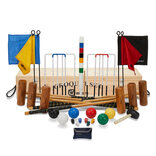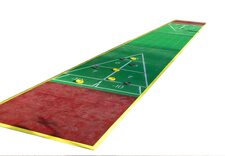The Rules of Stoolball
Stoolball is a pub game of the same family as cricket played almost exclusively in Sussex, England. Variations of the game probably exist and where there is doubt, the locally played rules should always apply. Please note that 1 metre = 100 cm = 3.28 feet.
See also: Outdoor & Garden Games.
Description
A Stoolball should measure between 175 - 190mm (7 - 7.5 inches) in circumference & weigh between 55 - 70 gms (2 - 2.5 ozs). A Stoolball bat is a wooden oval shaped paddle with a short handle that must not be longer than 460mm (18 inches) long nor more than 200mm (7.75 inches) diameter. The game is played on a large grass area in the middle of which is a strip of grass with a target board at either end. The strip of grass is called the "wicket" and, confusingly, each target is also termed a "wicket". Each target wicket is a 30mm (1 foot) square board fixed to a stake embedded in the ground so that the wickets face each other at a distance of 14.6m (16 yards). The top of each wicket must be 1.4m (4ft, 8 inches) from the ground and the bottom 600mm (24 inches) of each stake should be painted a different colour - the line where the colour changes in the "no ball" line. In front of each wicket a line called a "bowling crease" must be marked 9.15m (10 yards) from the wicket from left to right across the wicket area. Each line should be 900mm (1 yard) long and at either end, further lines called "extended returns" exist, running 300mm (1 foot) perpendicularly back towards the wicket.
Objective and Preliminaries
A Stoolball match is played by 2 teams of 11 or less players. In mixed games there should be a maximum of six men in each team. Each team has one "innings" in which their players "bat" and attempt to score "runs" (points) while the opposing team "bowls" aiming to get the batsmen "out" and limit the number of runs scored. Each set of eight balls delivered by a bowler is called an "over" and an innings ends either when the set number of overs has been played or when all but one batsmen are out. To begin, the captains of each team decide the number of overs that will be played, toss a coin to determine which team will bat first and agree the boundaries of the pitch. The latter should ideally be around 40m (45 yds) from the middle of the wicket. A rope or other objects can be put down to mark the boundary but garden borders, fences or anything clearly delimited will do. To start, the first two batsmen position themselves in front of each wicket and the other team spread out over the pitch in order to "field" the ball as quickly as possible after the batsmen strikes it. The most important "fielder" is the "wicket keeper" who stands directly behind the wicket being bowled at. For each over, a bowler is chosen by the captain and that person must bowl eight legitimate balls from within a bowling crease aiming to hit the wicket at the other end. The batsman who is at the target wicket tries to ensure that ball does not hit the wicket while also attempting to score runs. Both of these objectives are usually achieved by hitting the ball with the bat. Each over is bowled in the opposite direction to the previous over and the same person must not bowl two overs consecutively. This necessitates the fielders changing position between overs.
Bowling
A bowler must deliver the ball:
- only when the batsmen is ready
- underarm
- with both feet behind the bowling crease and within the bowling crease returns
- above the no-ball line on the stake
- so that it does not bounce before the wicket
Scoring Runs
A run is scored if both batsmen run from one wicket to the opposite wicket, passing each other en-route and touch the wicket or stake upon arrival. The batsmen can run backwards and forwards between the wickets scoring runs in this fashion after the ball has been struck for as long as they judge it is safe to do so. The batsmen will normally stop running as soon as they perceive there is any chance that one of them might be "run out". Four runs are automatically scored if the ball hits or crosses the boundary having first touched the ground. Six runs are automatically scored if the balls crosses the boundary without first touching the ground. Whenever a boundary is scored like this, any runs that the batsmen ran between the wickets are ignored. If the batsman fails to hit a legitimate delivery but nonetheless runs are still obtained, these runs are referred to as "byes". If the fielders make a mistake and allow the batsmen to score more runs when they had previously stopped running, these are called "overthrows". If some runs have been scored by running between the wickets and then the fielders err so badly that they throw the ball over the boundary, the 4 runs for the boundary are given in addition to the runs already scored.
Dismissals
There are three ways that a batsman can be dismissed.
- A batsman is "bowled out" if the bowler bowls a legitimate delivery and the ball hits the wicket, even if the ball first hits the bat or part of the batsman. A batsman is also bowled out if, in the opinion of the umpire, the ball would have hit the wicket had it not been prevented from doing so by any part of the batsman's body except the hand holding the bat.
- The batsman is "caught out" if the ball is struck by the bat and then caught by a fielder without first touching the ground.
- A batsman is "run out" if the a fielder successfully hits the wicket with the ball while the batsman are between wickets. If the batsmen decide to run, and a wicket is hit by the ball before they pass each other, the batsman who was running from that wicket is out. If the wicket is touched by the ball after they cross, then the batsman running to that wicket is out. A batsman is not out if that person is obstructed from reaching the wicket by a member of the opposing team.
These rules are provided by Masters Traditional Games, an Internet shop selling quality traditional games, pub games and unusual games. For general information or for copying and copyright, see our Rules Information page.
Our rules are comprehensive instructions for friendly play. If in doubt, always abide by locally-played or house rules.
Copyright James Masters, 2025. All rights reserved.


























